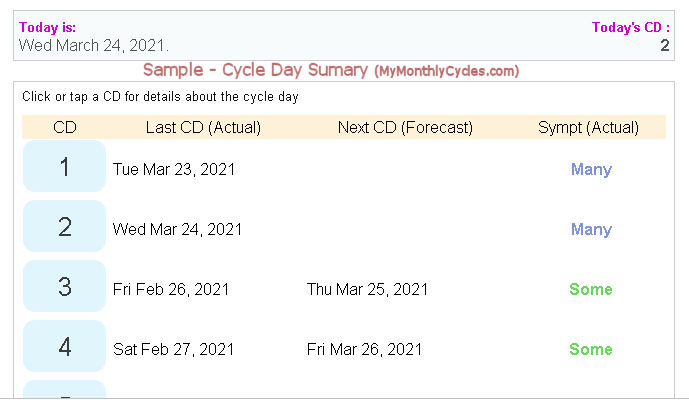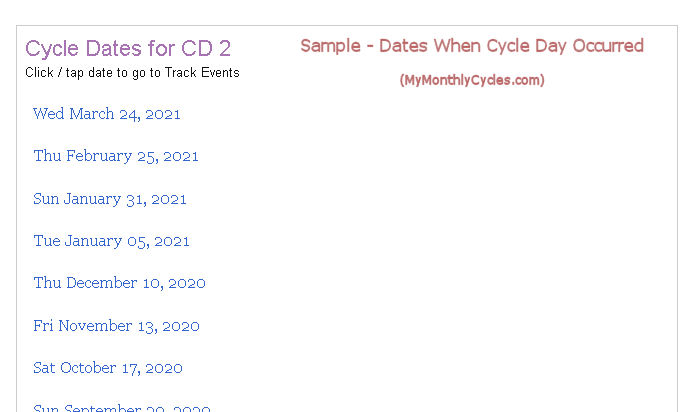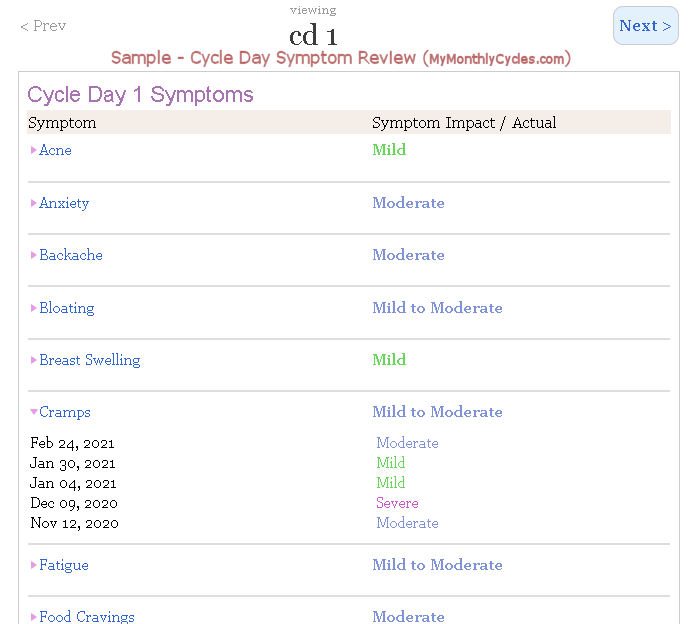Cycle Day Analysis / Forecast
Get a better understanding of your cycles by reviewing each cycle day (CD) you've tracked in MyMonthlyCycles. For each, see exactly when it last occurred, projected next date, and a summary of symptoms across cycles. Click or tap into any cycle day for details: every date for the cycle day, when symptoms happened and symptom impact forecast.
Sample Cycle Day Report
On the top part of report: a complete list of your cycle days (left column), including summary of how symptoms impact your day. Click or tap a Cycle Day for more info, shown below.

Every past date on which the selected Cycle Day occurred is enumerated. Many MyMonthlyCycles reports list your Cycle Day 1 dates - that is, the first day of your period. With this report, you can review dates for other cycle days.

This report section zooms into symptom activity for the Cycle Day, providing a symptom impact score calculated by severity levels that occurred, on this Cycle Day, in the past. Use the Open All button to view specific tracked dates per symptom, or click/tap on any symptom of interest.

About Cycle Day Analysis and Forecast
Cycle Day (CD) indicates where you are in your menstrual cycle. Cycle Day 1 (CD 1) is always the first day of your cycle: the day your period starts. Cycle Day 2 is the second day of your cycle, which is period day 2. Your cycle day count advances by 1 as you move through each cycle phase: follicular, ovulation, and the luteal phase. The Follicular and Luteal Phase Chart shows your cycle phases, and the number of cycle days per phase.
Many tools in MyMonthlyCycles use your automatically calculated Average Cycle Length (ACL) to project various cycle events, such as ovulation or the start date of your next period.
This cycle day report uses Average Cycle Length, when forecasting Next Cycle Day Date, but only for CDs that have not yet occurred in the current cycle and which are not larger than ACL.
About Cycle Day Range
When logged in, your CD list will display at the top of the page.
CD startYour list will always start at CD 1.
CD endThe last CD in the list can vary, since it's based on your cycle tracking. Because you likely have cycle/symptom activity in cycles longer than your average cycle, the end CD is generally set to your longest cycle*. Moreover, if your current (ongoing) cycle is longer still, its current CD is used*.
*Note: The maximum CD currently supported on this report is 60 days. See Reviewing Your Cycles, on the sidebar of this page for more info.
About Last Cycle Day Column
If some of the results in your Cycle Day report seem surprising, some explanation should help clarify. For each cycle day, the actual date on which it last occurred displays, if possible; it is not possible if you have not tracked at least your last period. If you've tracked at least one cycle, the report determines the most recent date a Cycle Day occurred. Generally, the Last CD date increments by one day for each CD, so CD 2 is the date after CD 1, etc.
But, at one or more points in your CD list, the Last CD date can jump to a previous cycle, and be before the CD date in the row(s) above it. This can occur if you are only partly through your current cycle, such that the CD in question has not yet occurred. Or, because the CD is larger than the length of the cycle being reviewed.
Example: Let's say your max cycle length is 31 days. You are currently on CD 12. Consequently, CD 13 and later have not yet occurred in this cycle. The date for CD 1 will be the start of your last menstrual period (LMP); the date for CD 2 will be the date following LMP, and so forth. When the report gets to CD 13 (or later) it has not yet occurred in your current cycle. Therefore, the report looks back at your history for the most recent previous cycle having a CD 13. Let's also suppose your previous cycle was 29 days. When the report gets to CD 30, it can not locate CD 30 in your previous cycle, so it looks back in your tracking history until it finds the most recent cycle having at least 30 days.
Disclaimer: The information on this cycle symptom forecast is calculated and based on cycle events you've tracked, including first day of your period and symptoms. What is predicted may or may not occur on a given cycle day, since your cycles and associated symptoms can vary in any given cycle for a variety of reasons.
All information provided on this cycle forecast, including predictions of symptom events, is for informational purposes only. It is not intended as a substitute for advice provided by a medical doctor or qualified healthcare provider. You should not use this information for self-diagnosis or for treating a health problem or disease. If you have any questions whatsoever about your medical health or believe you have a medical problem or disease, you should contact your medical doctor or healthcare provider.


